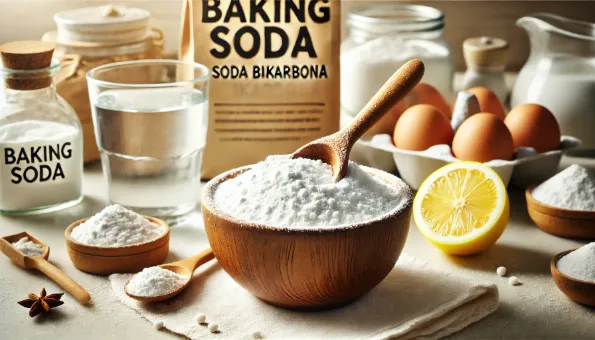Baking Soda (Sodium Bicarbonate): Alkaline Leavening Workhorse & Household Multi-Tool
This single salt releases CO₂ with acid + heat, lightening cakes, tenderising legumes and neutralising acidic flavours—use precisely; excess leaves soapy taste and adds sodium.

What Is Baking Soda?
Baking soda is **pure sodium bicarbonate (NaHCO₃)**—a white, alkaline crystalline powder. In batter or dough it reacts with acids (lemon juice, buttermilk, brown sugar (molasses), yogurt, cocoa (natural), vinegar) to release **carbon dioxide gas** that expands cells for rise.
Chemistry & Function
- **Primary reaction:** NaHCO₃ + H⁺ → Na⁺ + CO₂ ↑ + H₂O.
- Works **immediately on mixing**; over-mixing or resting allows gas to escape—bake promptly.
- Alkalinity (pH > 8) **accelerates Maillard browning** (cookies, pretzels) and can soften pectin (vegetables & beans).
Nutrition (approx. ¼ tsp • 1.2 g)
| | Amount |
|---|---|
| Calories | 0 |
| **Sodium** | ~330 mg |
| Carbs / Fat / Protein | 0 |
Not a micronutrient source; **functional additive only**.
Culinary & Practical Benefits
- **Leavening** for quick breads, pancakes, muffins when acidic component present.
- **Browning & spread control:** small soda + minimal acid yields darker, crisper cookies.
- **Tenderising legumes/veg:** a *pinch* in soak water reduces cooking time; prevents pigment loss in chlorophyll if controlled.
- **Acid moderation:** balances excessive acidity (tomato sauce) with *⅛ tsp at a time*.
- **Odor neutraliser & cleaning aid:** mild abrasive + deodoriser (multi-use reduces need for separate products).
Drawbacks & Precautions
- **Excess sodium:** frequent large culinary use adds dietary sodium (330 mg per ¼ tsp).
- Too much causes **soapy/alkaline taste & yellow crumb**; can weaken gluten (collapse).
- Over-alkalising vegetables turns chlorophyll to dull olive, and mushes texture.
- **Do not substitute for baking powder 1:1** (baking powder includes acid + stabilisers).
- Large ingestion (e.g., antacid misuse) can disrupt **electrolyte balance**; avoid medicinal self-dosing without guidance.
Culinary Uses & Ratios
- Typical use: **¼ tsp (1.2 g) per 1 cup (120 g) flour** *when sufficient acid is present*.
- For cocoa cakes: pair with natural (non-Dutch) cocoa; Dutch-processed often needs added acid (buttermilk or cream of tartar).
- Pretzels: brief dip in alkaline solution (often baking soda solution or lye) for deep brown crust.
- Beans: < ⅛ tsp per cup dry beans in soak water can cut cook time ~15–20%; rinse before simmering.
Storage & Potency Testing
Store **airtight, cool & dry** (moisture triggers premature reaction). Potency test: stir ¼ tsp soda into 2 tsp vinegar—vigorous fizz = active. Replace open boxes after ~6 months for optimal lift (earlier if used as fridge deodoriser).
Sustainability Notes
Sodium bicarbonate production (trona mining or Solvay process) has a **lower environmental impact per functional use** compared to multiple specialised cleaning or deodorising products. Buying in bulk for culinary + household tasks reduces packaging waste.
Key Takeaways
✔︎ Rapid gas release leavener & browning aid
✔︎ Multi-use (baking, tenderising, deodorising) reduces product clutter
✖︎ Adds sodium & off-flavours if overused—measure carefully.
- 1. Baking Soda

